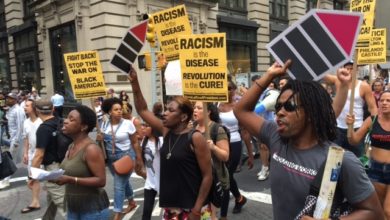On March 26 one thousand people from the Sacramento community marched to carry out the legacy of Cesar Chávez and the farmworkers’ struggle.
For the past decade and a half the Cesar Chávez March has brought together thousands of people to fight for important issues facing the working class. The march has called for a $15 living wage, for equality for women and for an end to imperialist war. It has been in the vanguard of the Chicano and Latin American people’s liberation movements, by consistently calling for an end to deportations and for and end of all racist policies.
Chávez and the farmworkers movement of the 1960s paved the way by organizing the community, and today the Chávez March is actively continuing this struggle. We must continue the struggle because today’s conditions have only gotten worse for the majority of working people, people of color, women and all oppressed people.
Driscoll and internationalism
This year’s march focused attention to solidarity with the heroic struggle of the San Quintin Mexican laborers against Driscoll’s fruit company. Currently the workers of San Quintin, Mexico have for more than a year led a huge strike of thousands of farmworkers against their deplorable working conditions. These workers pick fruit that are sold internationally to U.S. and Asian markets. Yet despite the gross enormous corporate profits, the workers only receive $3 an hour!
Read Liberation’s coverage of the recent historic San Quintin march to the U.S.-Mexico border.
In today’s economy; profit does not discriminate, and capital can travel freely internationally to oppress workers across borders. It’s not a rare occurrence for a U.S. company to take commodities at depressed costs from oppressed Mexican workers, and turn around to sell them at inflated costs to oppressed U.S. workers. Today’s struggle must be equally international in scope in order to take on the system. We must build unity across borders and nationalities.
Students and Youth Contingent
Huge contingents came from middle and high schools to participate in the march. Deep in the march there was a high school marching band. The band keep
the pace of the march going and kept spirits high. In fact it was the high schools and other youths who were the most fierce and excited chanters.
Young people chanted “Si se puede” and “Sin justicia no hay paz,” which mean “Yes we can” and “Without justice there is no peace.” Ten year old Fernando has become a staple at these marches as he repeatedly took to the ANSWER Coalition’s sound system and encouraged his peers to speak up. As the march began he told the people “I can’t hear you, I know you can do better! I want to hear you!”.
Many university students were also present. At the closing rally Party for Socialism and Liberation organizer Maile Hampton spoke on behalf of the UC Davis occupation which for weeks has taken over MRAK hall to demonstrate and demand the dismissal of corrupt university chancellor Katehi.
University professors were also present at the march. The California Faculty Association marched in a contingent and spread word of their upcoming strike. On April 13 the professors are going on a weeklong, statewide strike over the many labor issues they have been facing for years. The CFA is one of the biggest faculty unions in the country and will be shutting down 23 campuses across the state. The Fast Food Workers union and Fight for 15 were also present at the march; they are also set to go on a one day national strike on April 14.
The march was characterized by what is needed more than ever; unity. In addition to the groups and movements mentioned there were organizations promoting Muslim and Palestinian rights and Black Lives Matter. The Brown Berets and the Party for Socialism and Liberation, two organizations fighting for the revolutionary liberation of Chicano and working people, came together and marched side by side.






